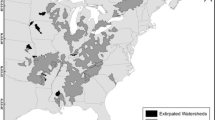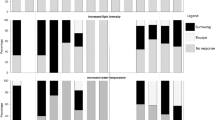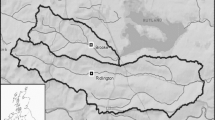Abstract
The behavior of animals can change when they become invasive. Whilst many species demonstrate exaggerations of existing behaviors, signal crayfish (Pacifastacus leniusculus) display a novel burrowing activity in some invaded rivers. Understanding if burrowing is learned or innate is important for modelling the geomorphological effects of invasion into new territories. Mesocosm experiments were undertaken with signal crayfish to investigate the effects of population density, shelter availability, and population provenance on their likelihood to burrow. Crayfish were collected within their native range in the USA; a recently invaded site in the USA; and two well-established invasive populations in the UK—one where burrowing in the field was present, and one population where burrowing in the field was absent. Crayfish from all populations constructed burrows in laboratory experiments. Population density and shelter availability were significant drivers of burrowing. There was no difference in burrowing between the invasive UK populations and the US native population, suggesting that burrowing is an innate, rather than learned, behavior. Therefore, crayfish have the capacity to affect geomorphic processes in any river that they invade, regardless of the source population. However, crayfish from the recently invaded USA river excavated more sediment than crayfish from their native range. These results demonstrate high plasticity of signal crayfish activities and show that innate behavioral strategies not seen in the native range can be activated at invaded sites.





Similar content being viewed by others
Data availability
Data are attached as supplementary materials.
References
Acquistapace P, Hazlett BA, Gherardi F (2003) Unsuccessful predation and learning of predator cues by crayfish. J Crustac Biol 23(2):364–370. https://doi.org/10.1163/20021975-99990346
Albertson LK, Daniels MD (2018) Crayfish ecosystem engineering effects on riverbed disturbance and topography are mediated by size and behavior. Freshw Sci 37(4):836–844. https://doi.org/10.1086/700884
Amici F, Widdig A, Lehmann J, Majolo B (2019) A meta-analysis of interindividual differences in innovation. Anim Behav 155:257–268. https://doi.org/10.1016/j.anbehav.2019.07.008
Arbilly M, Laland KN (2017) The magnitude of innovation and its evolution in social animals. Proc R Soc B 284(1848):20162385. https://doi.org/10.1098/rspb.2016.2385
Axelsson E, Nyström P, Sidenmark J, Brönmark C (1997) Crayfish predation on amphibian eggs and larvae. Amphib-Reptil 18(3):217–228
Bai S, Lung WS (2005) Modelling sediment impact on the transport of fecal bacteria. Water Res 39(20):5232–5240. https://doi.org/10.1016/j.watres.2005.10.013
Bates D, Maechler M, Bolker B, Walker S (2015) Fitting linear mixed-effects models using lme4. J Stat Softw 67(1):1–48. https://doi.org/10.18637/jss.v067.i01
Bergman DA, Moore PA (2003) Field observations of intraspecific agonistic behavior of two crayfish species, Orconectes rusticus and Orconectes virilis, in different habitats. Biol Bull 205(1):26–35
Berrill M, Chenoweth B (1982) The burrowing ability of nonburrowing crayfish. Am Midland Natural. https://doi.org/10.2307/2425310
Bilotta GS, Brazier RE (2008) Understanding the influence of suspended solids on water quality and aquatic biota. Water Res 42:2849–2861. https://doi.org/10.1016/j.watres.2008.03.018
Blake MA, Hart PJB (1993) The behavioral responses of juvenile signal crayfish Pacifastacus leniusculus to stimuli from perch and eels. Freshw Biol 29:89–97. https://doi.org/10.1111/j.1365-2427.1993.tb00747.x
Bojko J, Burgess AL, Baker AG, Orr CH (2021) Invasive non-native crustacean symbionts: diversity and impact. J Invertebr Pathol 186:107482
Bubb DH, Thom TJ, Lucas MC (2004) Movement and dispersal of the invasive signal crayfish Pacifastacus leniusculus in upland rivers. Freshw Biol 49(3):357–368
Butler DR (1995) Zoogeomorphology: animals as geomorphic agents. Cambridge University Press, Cambridge
Capelli GM, Hamilton PA (1984) Effects of food and shelter on aggressive activity in the crayfish Orconectes rusticus (Girard). J Crustac Biol 4(2):252–260. https://doi.org/10.2307/1548022
Chadwick DD, Pritchard EG, Bradley P, Sayer CD, Chadwick MA, Eagle LJ, Axmacher JC (2021) A novel ‘triple drawdown’ method highlights deficiencies in invasive alien crayfish survey and control techniques. J Appl Ecol 58(2):316–326. https://doi.org/10.1111/1365-2664.13758
Chadwick DDA (2019) Invasion of the signal crayfish, Pacifastcus leniusculus, in England: implications for the conservation of the white-clawed crayfish, Austropotamobius pallipes. Published PhD Thesis, University College, London
Crooks JA (2002) Characterizing ecosystem-level consequences of biological invasions: the role of ecosystem engineers. Oikos 97:153–166. https://doi.org/10.1034/j.1600-0706.2002.970201.x
Emery-Butcher HE, Beatty SJ, Robson BJ (2020) The impacts of invasive ecosystem engineers in freshwaters: a review. Freshw Biol 65:999–1015. https://doi.org/10.1111/fwb.13479
Environment Agency (2022) Environment Agency water quality archive web-site. Available at: environment.data.gov.uk/water-quality. [Access date 19th October 2022]
Faller M, Harvey GL, Henshaw AJ, Bertoldi W, Bruno MC, England J (2016) River bank burrowing by invasive crayfish: Spatial distribution, biophysical controls and biogemorphic significance. Sci Total Environ 569–570:1190–1200. https://doi.org/10.1016/j.scitotenv.2016.06.194
Fei S, Philips J, Shouse M (2014) Biogeomorphic impacts of invasive species. Annu Rev Ecol Evol Syst 45:69–87. https://doi.org/10.1146/annurev-ecolsys-120213-091928
Findlay JD, Riley WD, Lucas MC (2015) Signal crayfish (Pacifastacus leniusculus) predation upon Atlantic salmon (Salmo salar) eggs. Aquat Conserv Mar Freshwat Ecosyst 25(2):250–258
Fjälling AB (1995) Crayfish traps employed in Swedish fisheries. Freshwater Crayfish 8:201–214
Gherardi F (2013) Crayfish as global invaders: distribution, impact on ecosystem services and management options. Freshwater Crayfish 19(2):177–187
Green SJ, Atkins JL, Cote IM (2011) Foraging behavior and prey consumption in the Indo-Pacific lionfish on Bahamian coral reefs. Marine Ecol Progr Series 433:159167. https://doi.org/10.3354/meps09208
Griffin AS, Guez D (2014) Innovation and problem solving: a review of common mechanisms. Behav Proc 109:121–134. https://doi.org/10.1016/j.beproc.2014.08.027
Gruber J, Brown G, Whiting MJ, Shine R (2017) Geographic divergence in dispersal-related behavior in cane toads from range-front versus range-core populations in Australia. Behav Ecol Sociobiol 71:38. https://doi.org/10.1007/s00265-017-2266-8
Guan RZ (1994) Burrowing behavior of signal crayfish, Pacifastacus leniusculus (Dana), in the river great Ouse, England. Freshwater Forum 4:155–168
Guan RZ, Wiles PR (1997) The home range of signal crayfish in a British lowland river. Freshw Forum 8:45–54
Harvey GL, Moorhouse TP, Clifford NJ, Henshaw AJ, Johnson MF, Macdonald DW, Reid I, Rice SP (2011) Evaluating the role of invasive aquatic species as drivers of fine sediment-related river management problems: the case of the signal crayfish (Pacifastacus leniusculus). Progr Phys Geogr 35:517–533. https://doi.org/10.1177/2F0309133311409092
Harvey GL, Henshaw AJ, Moorhouse TP, Clifford NJ, Holah H, Grey J, Macdonald DW (2014) Invasive crayfish as drivers of fine sediment dynamics in rivers: field and laboratory evidence. Earth Surf Proc Land 39:259–271. https://doi.org/10.1002/esp.3486
Hastings A, Byers JE, Crooks JA, Cuddington K, Jones CG, Lambrinos JG, Talley TS, Wilson WG (2007) Ecosystem engineering in space and time. Ecol Lett 10:153–164. https://doi.org/10.1111/j.1461-0248.2006.00997.x
Hazlett BA, Acquitapace P, Gherardi F (2002) Differences in memory capabilities in invasive and native crayfish. J Crustac Biol 22(2):439–448. https://doi.org/10.1163/20021975-99990251
Holdich DM, Reeve ID (1991) Distribution of freshwater crayfish in the British Isles, with particular reference to crayfish plague, alien introductions and water quality. Aquat Conserv Mar Freshwat Ecosyst 1(2):139–158
Holway DA, Suarez AV (1999) Animal behavior: an essential component of invasion biology. Trends Ecol Evol 14(8):328–330. https://doi.org/10.1016/S0169-5347(99)01636-5
Houghton RJ, Wood C, Lambin X (2017) Size-mediated, density-dependent cannibalism in the signal crayfish Pacifastacus leniusculus (Dana, 1852) (Decapoda, Astacidea), an invasive crayfish in Britain. Crustaceana 90(4):417–435. https://doi.org/10.1163/15685403-00003653
Ion MC, Puha AE, Suciu T, Parvulescu L (2020) Get a grip: unusual disturbances drive crayfish to improvise. Behavior 157:101–120. https://doi.org/10.1163/1568539X-00003583
James J, Nutbeam-Tuffs S, Cable J, Mrugała A, Viñuela-Rodriguez N, Petrusek A, Oidtmann B (2017) The prevalence of Aphanomyces astaci in invasive signal crayfish from the UK and implications for native crayfish conservation. Parasitology 144(4):411–418
Johnsen SI, Taugbol T (2010a) NOBANIS – Invasive Alien Species Fact Sheet – Pacifastacus leniusculus. NOBANIS web-site. Available at: www.nobanis.org [Access date 27 Oct 2016]
Johnsen SI, Taugbol T (2010b) CABI – Pacifastacus leniusculus (American signal crayfish) datasheet. CABI web-site. Available at: https://www.cabi.org/isc/datasheet/70581#DA5AA83C-A614-422C-9468-AC2D413BCC3B. [Access date 29 May 2021]
Jones C, DiRienzo N (2018) Behavioral variation post-invasion: resemblance in some, but not all, behavioral patterns among invasive and native praying mantids. Behav Process 152:92–99. https://doi.org/10.1016/j.beproc.2018.05.011
Jones CG, Lawton JH, Shachak M (1994) Organisms as ecosystem engineers. In: Samson F, Knopf F (eds) Ecosystem management. Springer, New York, pp 130–147
Jones JI, Collins AL, Naden PS, Sear DA (2012a) The relationship between fine sediment and macrophytes in rivers. River Res Appl 28(7):1006–1018. https://doi.org/10.1002/rra.1486
Jones JI, Murphy JF, Collins AL, Sear DA, Naden PS, Armitage PD (2012b) The impact of fine sediment on macro-invertebrates. River Res Appl 28:1055–1071. https://doi.org/10.1002/rra.1516
Karatayev AY, Burlakova LE, Padilla DK, Mastitsky SE, Olenin S (2009) Invaders are not a random selection of species. Biol Invasions 11:2009–2019
Kemp P, Sear D, Collins A, Naden P, Jones I (2011) The impacts of fine sediment on riverine fish. Hydrol Process 25:1800–1821. https://doi.org/10.1002/hyp.7940
Kouba A, Petrusek A, Kozak P (2014) Continental-wide distribution of crayfish species in Europe: update and maps. Knowl Manag Aquat Ecosyst 413:5
Lane SN, Tayefi V, Reid SC, Yu D, Hardy RJ (2007) Interactions between sediment delivery, channel change, climate change and flood risk in a temperate upland environment. Earth Surf Proc Land 32(3):429–446. https://doi.org/10.1002/esp.1404
Larson ER, Olden JD (2011) The state of crayfish in the Pacific northwest. Fisheries 36(2):60–73. https://doi.org/10.1577/03632415.2011.10389069
Lea SE, Chow PK, Leaver LA, McLaren IP (2020) Behavioral flexibility: a review, a model, and some exploratory tests. Learn Behav 48:173–187. https://doi.org/10.3758/s13420-020-00421-w
Lefebvre L, Reader SM, Sol D (2004) Brains, innovations and evolution in birds and primates. Brain Behav Evol 63:233–246. https://doi.org/10.1159/000076784
Lenth RV (2016) Least-squares means: the R package lsmeans. J Stat Softw 69(1):1–33. https://doi.org/10.18637/jss.v069.i01
Levri EP, Luft R, Xiaosong L (2019) Predator detection and a possible dispersal behavior of the invasive New Zealand mud snail, Potamopyrgus antipodarum (Gray, 1843). Aquat Invasions 14(3):417–432
Lisle TE, Church M (2002) Sediment transport-storage relations for degrading, gravel bed channels. Water Resour Res 38(11):1219. https://doi.org/10.1029/2001WR001086
Magurran AE, Seghers BH, Carvalho GR, Shaw PW (1992) Behavioral consequences of an artificial introduction of guppies (Poecilia reticulata) in N Trinidad: evidence for the evolution of anti-predator behavior in the wild. Proceed Royal Soc B 248(1322):177–122. https://doi.org/10.1098/rspb.1992.0050
Marston RA, Girel J, Pautou G, Piegay H, Bravard JP, Arneson C (1995) Channel metamorphosis, floodplain disturbance and vegetation development, Ain River, France. Geomorphology 13:121–132. https://doi.org/10.1016/0169-555X(95)00066-E
Martin LB, Fitzgerald L (2005) A taste for novelty in invading house sparrows, Passer Domesticus. Behav Ecol 16(4):702–707
Mason RJ, Sanders H (2021) Invertebrate zoogeomorphology: a review and conceptual framework for rivers. WIREs Water 8(5):1540. https://doi.org/10.1002/wat2.1540
Mathers KL, White JC, Guareschi S, Hill MJ, Heino J, Chadd R (2020) Invasive crayfish alter the long-term functional biodiversity of lotic macroinvertebrate communities. Funct Ecol 34(11):2350–2361
Mery F, Burns JG (2010) Behavioral plasticity: an interaction between evolution and experience. Evol Ecol 24(3):571–583
Meysman FJ, Middelburg JJ, Heip CH (2006) Bioturbation: a fresh look at Darwin’s last idea. Trends Ecol Evol 21(12):688–695
Montana Field Guide (2019) Signal Crayfish — Pacifastacus leniusculus. Available at: http://fieldguide.mt.gov/. [Accessed 29th May 2021]
Mowery MA, Vink C, Mason AC, Andrade MC (2021) Behavioral, morphological, and life history shifts during invasive spread. Biol Invasions 23:3497–3511. https://doi.org/10.1007/s10530-021-02593-6
Pavlov DS, Mikheev VN, Dgebuadze YY (2006) Behavioral aspects of biological invasions of alien fish species. J Ichthyol 46:S117–S124
Peay S, Rogers D (1999) The peristaltic spread of signal crayfish (Pacifastacus leniusculus) in the River Wharfe, Yorkshire, England. Freshw Crayfish 12:665–676
Petrusek A, Filipová L, Kozubíková-Balcarová E, Grandjean F (2017) High genetic variation of invasive signal crayfish in Europe reflects multiple introductions and secondary translocations. Freshw Sci 36(4):838–850
Philips JD (2009) Biological energy in landscape evolution. Am J Sci 309(3–4):79–85. https://doi.org/10.1016/j.geomorph.2009.01.007
Phillips BL, Brown GP, Webb JK, Shine R (2006) Invasion and the evolution of speed in toads. Nature 439(7078):803–803
Pintor LM, Sih A (2009) Differences in growth and foraging behavior of native and introduced populations of an invasive crayfish. Biol Invasion 11(8):1895–1902
Ramalho RO, Anastacio PM (2011) Crayfish learning abilities: how does familiarization period affect the capture rate of a new prey item? Ecol Res 26(1):53–58. https://doi.org/10.1007/s11284-010-0754-7
Ranta E, Lindstrom K (1993) Body size and shelter possession in mature signal crayfish, Pacifastacus leniusculus. Ann Zool Fenn 30:125–132
Reader SM, Laland KN (eds) (2003) Animal Innovation (Vol. 10). Oxford University Press, Oxford
Reznick DN, Ghalambor CK (2001) The population ecology of contemporary adaptations: what empirical studies reveal about the conditions that promote adaptive evolution. Genetica 112:183–198. https://doi.org/10.1007/978-94-010-0585-2_12
Rice SP, Johnson MF, Reid I (2012) Animals and the geomorphology of gravel-bed rivers. In: Church M, Biron P, Roy A (eds) Gravel bed rivers: tools, processes, environments. Wiley, Hoboken, pp 49–62
Rice SP, Johnson MF, Mathers K, Reeds J, Extence C (2016) The importance of biotic entrainment for base flow fluvial sediment transport. J Geophys Res Earth Surf 21(5):890–906. https://doi.org/10.1002/2015JF003726
Sakai AK, Allendorf FW, Holt JS, Lodge DM, Molofsky J, With KA, Syndallas B, Cabin RJ, Cohen JE, Ellstrand NC, McCauley DE, O’Neil P, Parker IM, Thompson JN, Weller SG (2001) The population biology of invasive species. Annu Rev Ecol Syst 32(1):305–332. https://doi.org/10.1146/annurev.ecolsys.32.081501.114037
Sanders H, Mills DN (2022) Predation preference of signal crayfish (Pacifastacus leniusculus) on native and invasive bivalve species. River Res Appl 38(8):1469–1480
Sanders H, Rice SP, Wood PJ (2021) Signal crayfish burrowing, bank retreat and sediment supply to rivers: a biophysical sediment budget. Earth Surf Proc Land 46(4):837–852. https://doi.org/10.1002/esp.5070
Sanders H, Mason RJ, Mills DN, Rice SP (2022) Stabilization of fluvial bed sediments by invasive quagga mussels (Dreissena bugensis). Earth Surf Proc Land. https://doi.org/10.1002/esp.5455
Sanders H (2020) Biotic and abiotic controls of burrowing by signal crayfish (Pacifastacus leniusculus) and the implications for sediment recruitment to rivers. PhD Thesis, Loughborough University
Sidorchuk AY, Golosov VN (2003) Erosion and sedimentation on the Russian Plain, II: the history of erosion and sedimentation during the period of intensive agriculture. Hydrol Process 17:3347–3358. https://doi.org/10.1002/hyp.1391
Sol D, Lefebvre L (2000) Behavioral flexibility predicts invasion success in birds introduced to New Zealand. Oikos 90(3):599–605. https://doi.org/10.1034/j.1600-0706.2000.900317.x
Sol D, Weis JS (2019) Highlights and Insights from" biological invasions and animal behavior". Aquat Invasions 14(3):551–565. https://doi.org/10.3391/ai.2019.14.3.12
Sol D, Timmermans S, Lefebvre L (2002) Behavioral flexibility and invasion success in birds. Anim Behav 63(3):495–502. https://doi.org/10.1006/anbe.2001.1953
Stanton JA (2004) Burrowing behavior and movement of the signal crayfish Pacifastacus leniusculus (Dana). Published PhD Thesis, Department of Biology, University of Leicester
Statzner B (2012) Geomorphic implications of engineering bed sediments by lotic animals. Geomorphology 157–158:49–65. https://doi.org/10.1016/j.geomorph.2011.03.022
Statzner B, Peltret O (2006) Assessing potential abiotic and biotic complications of crayfish-induced gravel transport in experimental streams. Geomorphology 74(1–4):245–256. https://doi.org/10.1016/j.geomorph.2005.08.007
Suarez AV, Cassey P (2016) Introduction. In: Weis JS, Sol S (eds) Biological invasions and animal behaviour. Cambridge University Press, Cambridge, pp 1–4
van Schaik C, Graber S, Schuppli C, Burkart J (2017) The ecology of social learning in animals and its link with intelligence. Span J Psychol 19(e99):1–12. https://doi.org/10.1017/sjp.2016.100
Vila M, Basnou C, Pysek P, Josefsson M, Genovesi P, Gollasch S, Nentwig W, Olenin S, Roques A, Roy D, Hulme PE, DAISIE partners (2010) How well do we understand the impacts of alien species on ecosystem services? A pan-European, cross-taxa assessment. Front Ecol Environ, 8(3):135–144
Viles HA (1988) Biogeomorphology. Hoboken, Oxford
Weis JS (2010) The role of behavior in the success of invasive crustaceans. Marine Freshw Behav Physiol 43:83–98. https://doi.org/10.1080/10236244.2010.480838
Wentworth CK (1922) A scale of grade and class terms for clastic sediments. J Geol 30(5):377–392
Wright JP, Jones CG (2006) The concept of organisms as ecosystem engineers ten years on: progress, limitations and challenges. Bioscience 56(3):203–209. https://doi.org/10.1641/0006-3568(2006)056[0203:TCOOAE]2.0.CO;2
Wright TF, Eberhard JR, Hobson EA, Avery ML, Russello MA (2010) Behavioral flexibility and species invasions: the adaptive flexibility hypothesis. Ethol Ecol Evol 22(4):393–404. https://doi.org/10.1080/03949370.2010.505580
Acknowledgements
CHS acknowledges a studentship funded by Loughborough University School of Social Sciences and Humanities. This research was financially supported by the British Society for Geomorphology (Postgraduate Research Award), Royal Geographical Society (Dudley Stamp Memorial Award), and Santander (Santander Mobility Award) awarded to CHS, and Montana State University funding awarded to LA. In addition, thanks are due to Richard J. Mason, Benjamin B. Tumolo, Eric A. Scholl, J. Holden Reinhart, and in particular to Zachary Maguire for assistance in crayfish collection, to Richard J. Mason for support with statistical analyses, and to Richard Harland, Rebecca McKenzie, and Zachary Maguire for laboratory assistance.
Author information
Authors and Affiliations
Corresponding author
Ethics declarations
Competing interest
The authors have no competing interests to declare that are relevant to the content of this article.
Additional information
Publisher's Note
Springer Nature remains neutral with regard to jurisdictional claims in published maps and institutional affiliations.
Supplementary Information
Below is the link to the electronic supplementary material.
Rights and permissions
Springer Nature or its licensor (e.g. a society or other partner) holds exclusive rights to this article under a publishing agreement with the author(s) or other rightsholder(s); author self-archiving of the accepted manuscript version of this article is solely governed by the terms of such publishing agreement and applicable law.
About this article
Cite this article
Sanders, C.H., Rice, S.P., Wood, P.J. et al. River bank burrowing is innate in native and invasive signal crayfish (Pacifastacus leniusculus) and is driven by biotic and abiotic cues. Biol Invasions 25, 3425–3442 (2023). https://doi.org/10.1007/s10530-023-03115-2
Received:
Accepted:
Published:
Issue Date:
DOI: https://doi.org/10.1007/s10530-023-03115-2




